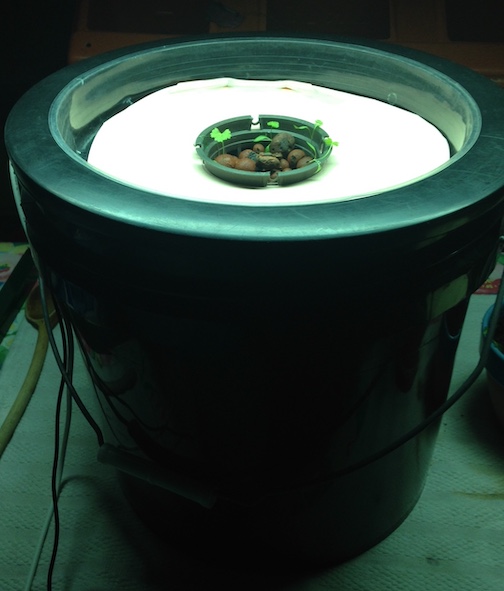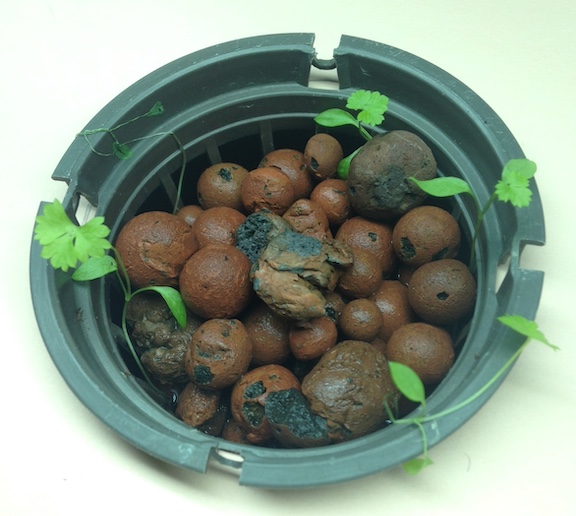 Today is my 26th day at home, following the West Virginia guidelines for shelter at home to prevent the spread of the coronavirus. Looking for things to do, I’m excited to explore the Kratky hydroponic method–a new process for me.
Today is my 26th day at home, following the West Virginia guidelines for shelter at home to prevent the spread of the coronavirus. Looking for things to do, I’m excited to explore the Kratky hydroponic method–a new process for me.
I’ve been experimenting with a variety of hydroponic systems at home and working with K-12 and college-level STEAM (science, technology, engineering, art, and math) programs since 2013. However, I only recently learned about the Kratky Method.
 The Kratky Method is the simplest form of hydroponics because it requires only a reservoir of nutrient fluid and something to hold up the plant. This is a totally passive hydroponic system. The air water strategy is based on plant growth–as the plant and its root system grow, the reservoir liquid evaporates and exposes more of the root system to air, which allows the roots to increase oxygenation.
The Kratky Method is the simplest form of hydroponics because it requires only a reservoir of nutrient fluid and something to hold up the plant. This is a totally passive hydroponic system. The air water strategy is based on plant growth–as the plant and its root system grow, the reservoir liquid evaporates and exposes more of the root system to air, which allows the roots to increase oxygenation.
I’ve set up my Kratky system using a an opaque, food-safe 5-gallon bucket, which is large enough to contain all the liquid needed for my cilantro (Coriandrum sativum) seedlings to reach maturity. The bucket I’m using didn’t come with a lid, so I’ve improvised a cover using a plastic saucer that rests inside the bucket top perfectly. Since the saucer is clear and would allow algal growth in the plant nutrient water, I’ve created an opaque cover for the saucer out of card stock.
 I was glad to find the plastic saucer, because it was easier to trace and cut out an opening to house my net pot containing the cilantro seedlings and hydroton substrate. I had germinated my cilantro seeds in seed starter pellet. Once the seedlings expressed four leaves and root tales at least two inches long, I transferred four plants to the Kratky set up. I’d let the seedlings grow on a windowsill, which really didn’t provide a strong enough light for the plants to develop properly. You can see that my seedlings are quite spindly. Transferring these delicate stem-threads was difficult, and I lost at least four plants during the transplant process.
I was glad to find the plastic saucer, because it was easier to trace and cut out an opening to house my net pot containing the cilantro seedlings and hydroton substrate. I had germinated my cilantro seeds in seed starter pellet. Once the seedlings expressed four leaves and root tales at least two inches long, I transferred four plants to the Kratky set up. I’d let the seedlings grow on a windowsill, which really didn’t provide a strong enough light for the plants to develop properly. You can see that my seedlings are quite spindly. Transferring these delicate stem-threads was difficult, and I lost at least four plants during the transplant process.
The horticulturalist who devised this simple hydroponic method, is Dr. J.B. Kratky, based at the Beaumont Agricultural Research Center at the University of Hawaii. All of the nutrient solution is added prior to transplanting seedlings into the non-circulating hydroponic system. Plant growth and gradual evaporation reduces the nutrient solution level, creating an enlarging moist air space. Meanwhile, the root system expands and continues to absorb water and nutrients. As Kratky[1] explains, “The crop is harvested before the nutrient solution becomes exhausted.”
 For the nutrient solution, I used a one-time basic start-up dose of hydroponic liquid fertilizer Floranova[2] Grow (7:4:10) at the rate of 104 ml. Floranova Grow has 7% N, 4% P2O5, 10% K2O, 4% Ca, 2% S, 1.5% Mg, and 0.1% Fe and less than 0.1% of each micronutrient (B, Cl, Co, Mn, Mo, Zn).
For the nutrient solution, I used a one-time basic start-up dose of hydroponic liquid fertilizer Floranova[2] Grow (7:4:10) at the rate of 104 ml. Floranova Grow has 7% N, 4% P2O5, 10% K2O, 4% Ca, 2% S, 1.5% Mg, and 0.1% Fe and less than 0.1% of each micronutrient (B, Cl, Co, Mn, Mo, Zn).
I set up the Kratky system near a window in my basement. For additional lighting I am using a T5 HO 24Watt 22-inch Jump Start grow light distributed by HydroFarm[1]. The system includes a light fixture with a reflective finish that helps direct more light to the plants. I chose the 4-foot light stand, which includes a toggle clamp for adjusting light height. I use a timer to give the plants fourteen hours of light per day.
Under optimal nutrient fluid, temperature, air, and lighting conditions my cilantro plants should reach 80 cm in 15 weeks. This gives me a specific goal to reach. I transferred the seedlings to the Kratky system on April 15, so my cilantro plants should reach maturity by July 29. I may harvest them sooner, as I enjoy the texture and taste of younger leaves.
I’ll share photos as the cilantro grows. I will post a follow-up blog when I harvest the cilantro. I really hope this works well…I’ll let you know.
Update, 13 May 2020: Below are photos of my cilantro at 1, 2, 3, and 4 weeks. I think they’re looking great!

_____________
[1] Hydrofarm East, 270 Canal Road, Fairless Hill, PA 19030-4303 on the web at: Hydrofarm.com
[1] Kratky, B.A. 2009. Three non-circulating hydroponic methods for growing lettuce. Proceedings of the International Symposium on Soilless Culture and Hydroponics. Acta. Hort. 843:65-72. Available for download at: https://www.ctahr.hawaii.edu/hawaii/downloads/Three_Non-circulating_Hydroponic_Methods_for_Growing_lettuce.pdf
[2] General Hydroponics Inc., Sebastopol, CA. Website: http://www.generalhydroponics.com
